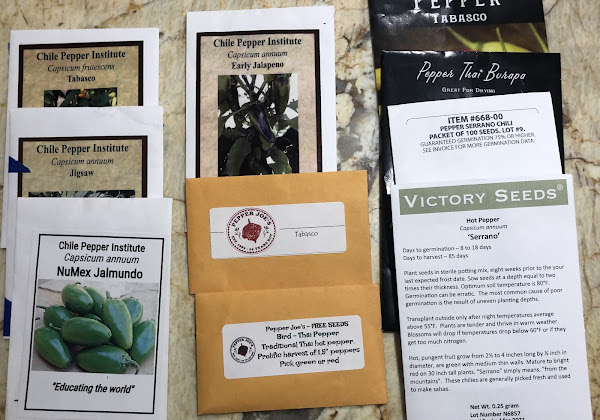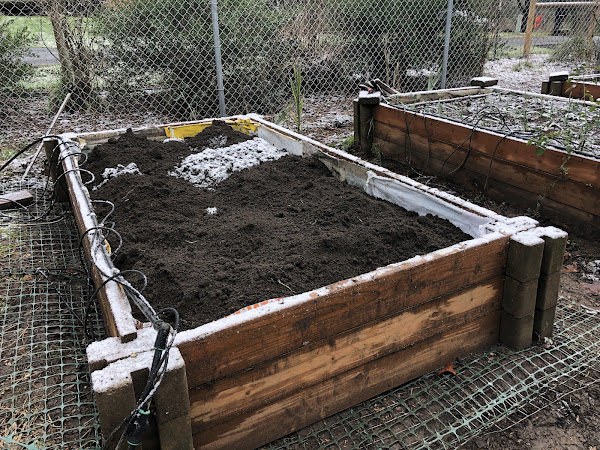This is an ambitious goal. There are all sorts of red cherry tomatoes out there. Most are hybrids, and most are sweet/tart but not the more complex, tomatoey flavor of heirlooms. Most grow tall and rangy. What I want is a dwarf, short interstem plant (brachytic dwarf) with true red tomatoes, cherry size, prolific production like clusters of grapes. I would like if they have jointed stems that break easily for easy harvest.
Last year I grew Dwarf Johnson Cherry Tomato. Not too far off except: The tomatoes are pink with pink flesh, too mild flavor, not jointed so they don't pick easily. It is a brachytic dwarf, so there's that, and I will grow them next year.
There are thousands of varieties out there. I certainly don't know them all or even most. In the end, I also want one that grows true from seeds, so hybrids also don't count.
I decided to try to be scientific about this. I will choose parents with suites of traits that, together, might help result in my goal.
(1) Livingston's Dwarf Stone - a red heirloom tomato, brachytic dwarf, introduced by the Livingston Seed Company in 1902. Not a huge size tomato. This line is ancestral to other brachytic dwarf tomatoes.
(2) Reisentraub. A German-developed, red heirloom cherry tomato, around since the mid-1800s. They bear huge clusters, like clusters of grapes (complex inflorescence), that are claimed to have heirloom beefsteak tomato flavors, bite size tomatoes.
I have not found a highly detailed yet clearly labeled (for the amateur) map of tomato chromosomes with associated traits, but I did see this example, which helps significantly. Based on that information, my main interests involve three chromosomes. Mainly two. Some link useful traits together, which will help.
Chromosome #1: locules, few=L and many=l (Capital letter is dominant). Compound inflorescence=s, simple inflorescence=S. I think Dwarf Stone is lS and Reisentraube is Ls.
Chromosome #3: Brachytic trait =b, normal internode length = B.
Chromosome #5: Jointed stems (for easy picking ) jointed is dominant (J). there is also a nipple tip trait, Reisentraub has it (nf) and jointed stem, Dwarf Stone does not (Nf) but I don't know about join ted stems. These traits will help later.
So as far as I can tell, Dwarf Stone is Chr #1: 1S Chr #3: B and Chr #5: jNf.
Reisentraub is Chr #1: LS Chr #3: b and Chr #5: Jnf.
I know there are lots of other genes involved, on these and the other of the tomato's 12 chromosomes, but this is what I have. Other traits & chromosomes might help in later generations to select for uniformity or flavor or tomato size, for example,
Now, Dwarf Stone has to be the female parent. All of Dwarf Stone 's seedlings should be normally be dwarf, a recessive trait. If the cross takes, the seedlings (F1 generation) will all carry a dwarf gene but they will grow normal height. That's how we know the cross took. A successful cross will have F1 generation with few locules (more likely cherry), simple inflorescence, red, jointed stem, yellow skin (so red fruit), no nipple trait.
Taking seeds from F1 generation and growing them out, 25% of seedlings will be brachytic dwarf (b). So plant lots of seeds, but discard any plants that grow normal height. Easy to identify at a couple of inches tall. When they bloom, if they have multiple inflorescence, from Reisentraub, they should also be two locule. Compound inflorescence is a recessive trait, so that should be 25% of F2 generation. Also, those will be purebred for both the inflorescence type, and as a marker for the dominant few-locule trait. Save only seeds with those traits.
Similarly, save only seeds for plants that have jointed stems and nipple trait. Nipple trait is recessive, and linked to jointed stem (which us dominant) so selecting for nipple trait, 25% of seedlings, will mean both that and the jointed stems are pure.
That isn't all but those are the traits I wanted. After growing out F3, choose the ones with cherry trait and best flavor, select those for saving seeds and further purifying until they are true to type, takes about 10 generations. There is no promise I will be gardening that long, but I think by watching how traits are linked on chromosomes and which are dominant vs. recessive, I can have a strain I feel good about in four generations. Another way to increase my chances would be back cross the F2 dwarfs with Reisentraube, and only grow out the dwarfs in F3. Then the offspring will be 75% Reisentraube, still brachytic dwarf, and maybe I would get there faster.
So those are my thoughts. There is probably a lot wrong with them, but we have to start somewhere. I think I'm at least good with the parent selection, what F2 might look like, and selecting brachytic trait and cherry tomato trait (few locules, although some salad tomatoes are bigger and also have few locules) (plus compound inflorescence) and nipple (plus jointed stem) trait. Those are a long way away and who knows what any of the uncertainties of life will bring. Then again, I might have fun and a nice variety in the end. Plus hopefully even the dead ends and mistakes will be tasty.



















































